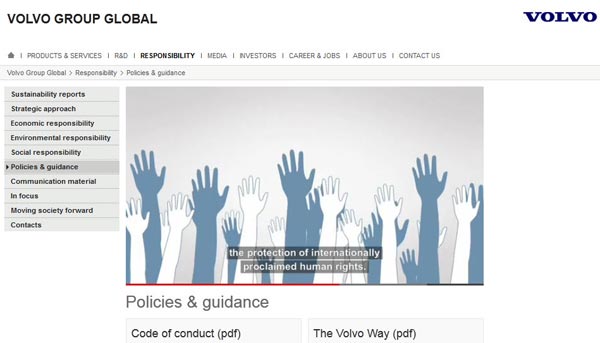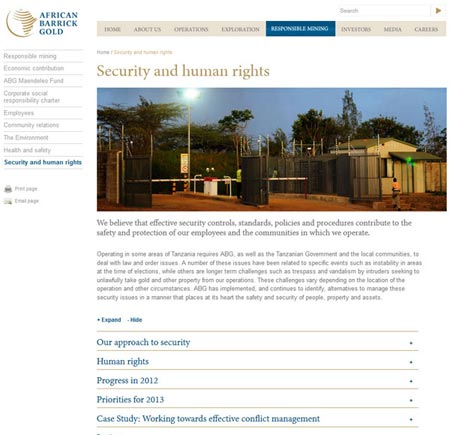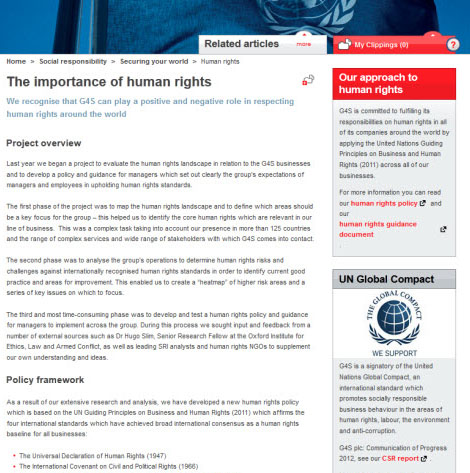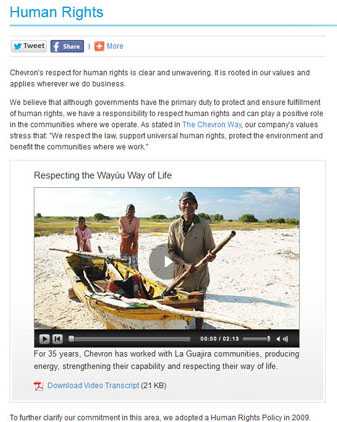
It’s easy for a company to say ‘We support the Universal Declaration of Human Rights’ on their website. Indeed, it would be astonishing to find a company prepared to say that it didn’t.
But how can you demonstrate that you genuinely do, and that you actively consider human rights in your business? Showing is always better than telling…
Here are a few examples of what some of the biggest companies do when discussing human rights on their corporate websites.
Show the relevance of human rights to your company
There are several items in the list of Rights, but there are four that might be particularly appropriate to consider:
- No discrimination
Diversity pages are increasingly common on corporate websites. Consider whether this is best placed in an About Us section, or in a Careers section. Note also, here in the UK, the need to consider diversity at Board level after the Davies Report.
- Freedom of association and the right to collective bargaining
This is much less frequently seen, but one example is Volvo, who make it clear that these principles are covered in their Code of Conduct (that page is called Human Rights in Operation). Another is Anglo American on their Labour Relations page where they outline their commitment to these rights. Both these companies extend their discussion of human rights on other pages across their sites.
- No slavery or forced labour
Child labour or forced labour is not relevant to all companies, but can crop up in several industries, especially in discussion of your supply chain. If there is any risk that your industry is one of these, consider discussing your approach to handling these issues in an Ethics or Corporate Social Responsibility section. (See examples of this below)
- Right to a private and family life
This one is probably only indirectly relevant, at least to most companies, but there are a few who make a point of associating work/life balance with this human right.
 You may have other, more relevant aspects to consider…
You may have other, more relevant aspects to consider…
For example, African Barrick Gold have an interesting explanation on Security and Human Rights of what they are doing as part of their human rights activity: training stakeholders in human rights and supporting local government and law enforcement agencies in providing training in adherence to international human rights norms.
Note the progress/priorities sections at the bottom of this section…
Create – and make available – a human rights policy
 G4S provide a page specifically about developing their policy—there’s also a press release announcing the new policy.
G4S provide a page specifically about developing their policy—there’s also a press release announcing the new policy.
Note that they have posted a letter from an external expert explaining his involvement, and confirming that he believes the people at G4S he has worked with have shown real intent to produce a meaningful policy. As in so many things, external assurance helps convince the reader.
There’s more: they’ve included a presentation on human rights available for download, and they’ve outlined the next steps in their project to evaluate the ‘human rights landscape’ at G4S: how they will promote and integrate the policy.
Don’t forget to include your human rights policy or statement on the website. It’s good to see PDF content written out in full, but if your policy is long, attach it in a PDF, and offer a summary on the webpage.
Explain in detail your approach to applying the policy ‘in real life’
Rio Tinto devote a long page to their human rights approach, covering:

- Policy (and date of update)
- Due diligence “avoiding involvement in human rights harm by others, including business partners”
- Respecting the diversity of indigenous peoples
- Human rights risks
- Approach: policy/procedures/training/risk analyses
- International commitments, partnerships and publications
Chevron includes human rights as one of their Global Issues and also discuss human rights on a dedicated page in their Corporate Responsibility Approach section, where they include video and offer links to a variety of PDFs and external resources, including their efforts to address the risk of forced labour and human trafficking in their supply chain.
These are all good ways to highlight your human rights activities.
Ideally, it’s a good idea to provide some measures of success as well. One option would to use the GRI framework to measure progress – National Grid, for example do this. Another idea would be to include external ratings/awards as evidence of success in different areas (e.g. Chevron include their rating of 100% on the Human Rights Campaign Corporate Equality Index in their CSR report). And including case studies in CSR reporting is a popular option.
Interestingly, Mondelez International has a discussion of their verification system on their CocoaLife site:
“A verification system is a way to give voice to the people in cocoa-growing communities and it’s one of the three core principles of the Cocoa Life program. A verification system is an external set of eyes and ears, both looking and listening, to make sure that the program is doing what it set out to do. It’s similar to the model of verifying in the financial sector where books are kept and then auditors check those books. The big difference, however, is that money is quantitative and should be black and white, while human rights are qualitative and therefore not as clear-cut.”
It’s worth a read: scroll down the page to see what Mil Niepold has to say about verification.
Extend your approach to your sphere of influence
Companies sometimes talk about their sphere of influence. Often this means working with suppliers and partners; sometimes it means working with governments or other organisations.
- Sector
Barclays and RBS both explain how they work with the Thun Group (an informal group of European banks) to create a discussion paper(PDF) for banks about business and human rights.
- Supply Chain
British American Tobacco have a page called Human Rights in the Supply Chain where they discuss how they incorporate human rights criteria into their major supply chain programmes.
They also specifically discuss the issue of child labour in cultures where children assist their parents in domestic/agricultural chores. Since BAT has an agricultural supply chain, this is clearly a very relevant issue for them. They link this page to other highly relevant pages on their site: Managing Human Rights, Social Responsibility in Tobacco Production, and their supplier assessment tool. This is a good example of how to interlink pages to demonstrate consistency and depth of approach.
- Government agencies
African Barrick Gold explain how they are working with the Tanzanian police force:
“ABG is the first and only private company to comprehensively engage with senior Tanzanian government officials and local law enforcement agencies to encourage and support the provision of Voluntary Principles [on Security and Human Rights] training to these agencies and the adherence to international human rights norms.”
Make it clear and interesting
And finally…
Sometimes policy pages are little more than a list of downloads. Consider using a different medium: for instance, Volvo Group provide a video outlining their approach; as we’ve seen, Chevron offer a case-study video discussing one particular aspect of their human rights policy.
And good use of language, font and layout can help. CapGemini communicate their sustainable procurement policy very clearly and the human rights elements can be clearly seen.
***
 This post is part of Blog Action Day, which this year is discussing human rights.
This post is part of Blog Action Day, which this year is discussing human rights.
Previous contributions to Blog Action Day have been:
2012: One Plus One Can Be Greater Than Two
2011: Lessons From Food Security: Telling Us What Matters
2010: Mixing Oil and Water
2009: Climate change and the corporate site
2008: Celebrating the FTSE 100: action on the breadline
2007: Enticing the green investor
Lucy is Editor at Corporate Eye

Hi Lucy!
I am pleased to be participating in the BAD2013 and having the opportunity to read what many people have to talk about their experiences and opinions.
Congratulations on your significant participation in Blog Action Day 2013.
Greetings from Sissym
Rio de Janeiro, Brazil